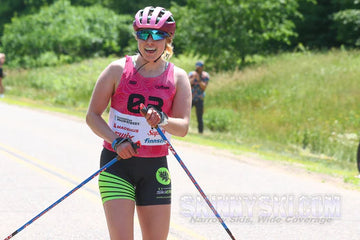
Enjoy this guest post from JoJé athlete Michaela Keller-Miller
Photo credit: Skinnyski.com/Bruce Adelsman. Used with permission.
Contrary to what one may assume about a sport that requires snow, cross country skiers train far more hours during the summer months than in the winter.
Personally, I spend my summers training in Craftsbury, Vermont, a mecca for all things outdoor sports. From endless gravel roads for long runs and gravel rides to a rollerski loop at the Craftsbury Outdoor Center, it’s easy to find ways to prep for the winter.
Without races to fill the schedule, skiers can turn their focus to building a base and improving technique, power, and speed. To train for these attributes, skiers dedicate several sessions per week to interval workouts and strength training.
How I train for cross country skiing
In a “normal” hard training week, I’ll do two sessions six days a week. Two of these sessions will be gym sessions, two are typically running or rollerski interval sessions, one involves sets of speeds (essentially sprints), and the rest are usually easy distance sessions. The goal of summer intervals is to improve both fitness and efficiency at speed.
Early summer intervals are typically at what skiers call L3 (level three), which is just below distance race pace and can be maintained for around 60 minutes of “on time.” A common interval set for skiers is 5-7x10 minutes at L3 pace.
In addition to rollerski intervals, we also do uphill running with poles intervals to add variety.
QUICK TRAINING TIP: Adding poles to running intervals is a great way to engage the full body which is beneficial to ski training. Running with poles also quickly increases lactate levels, which is great practice for when muscles flood toward the end of a race. It’s also effective in improving power.
One such running with poles workout is 1-2 sets of 6x1 minute on a somewhat steep uphill grade. The goal is to go as fast as possible for each minute, effectively pushing quickly to fatigue and working on explosive power.
While intervals are important fitness building blocks, distance sessions are truly the bread and butter of summer ski training. They’re great opportunities to work on small technical improvements, which can translate to huge gains come winter.

Photo credit: Skinnyski.com/Bruce Adelsman. Used with permission.
Distance sessions are at an easy pace that can be maintained for multiple hours at a time and vary from one-hour afternoon shakeout runs to three- to four-hour rollerski “over-distance” skis.
Speed sets can be added into shorter distance sessions; this could look like two sets of 6x15-20 second all-out sprints. Speed workouts aren’t meant to be incredibly tiring. Instead, the goal is to improve top-speed while maintaining good technique.
How I fuel for cross country skiing
My team trains in three-week blocks during the summer, which typically involves two weeks of 20-plus hours per week, followed by a recovery week of about 10 hours per week. This much training obviously requires adequate fueling and hydration to recover properly and to keep energy levels stable between workouts.
My go-to workout snack this summer has been JoJé bars.
QUICK TRAINING TIP: Whether I need a post-workout snack to start the recovery process or mid-workout fuel to avoid crashing energy levels by the end of a three-hour rollerski, I’ve found JoJé bars to be the perfect source of energy. Not only do they taste amazing, but they’re made with whole food ingredients that I can trust as an athlete.
JoJé offers a balance of simple and complex carbs for a steady release of energy, combined with the right amount of healthy fats and protein to keep energy levels steady, without upsetting your stomach. They’re perfect for keeping me fueled and avoiding a bonk!
Hydration is also important! In addition to drinking water, it’s key to think about electrolyte intake during all types of physical activity. Personally, I like to take one SaltStick Race Ready capsule with water every 30-60 minutes during a workout, which has the right balance of electrolytes to mirror what I’m losing in sweat.
Cross country ski training in the summer is the perfect time to progress fitness and technique with no races on the horizon. These goals are best met through a combination of interval, strength, and distance workouts. And of course, properly fueling and hydrating is just as important as the training itself to lock in summer gains!
Read about JoJé Founder Jess Cerra’s experience at her first cross country ski race (the Birkie!).






